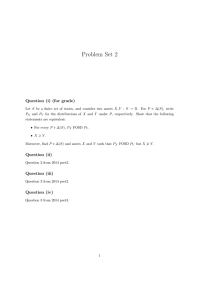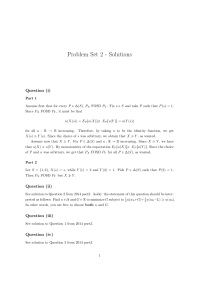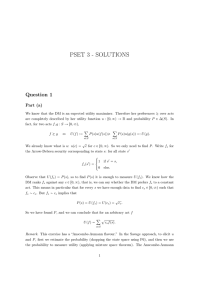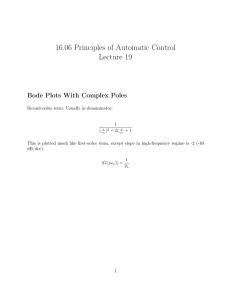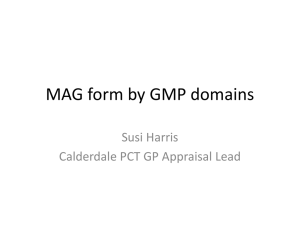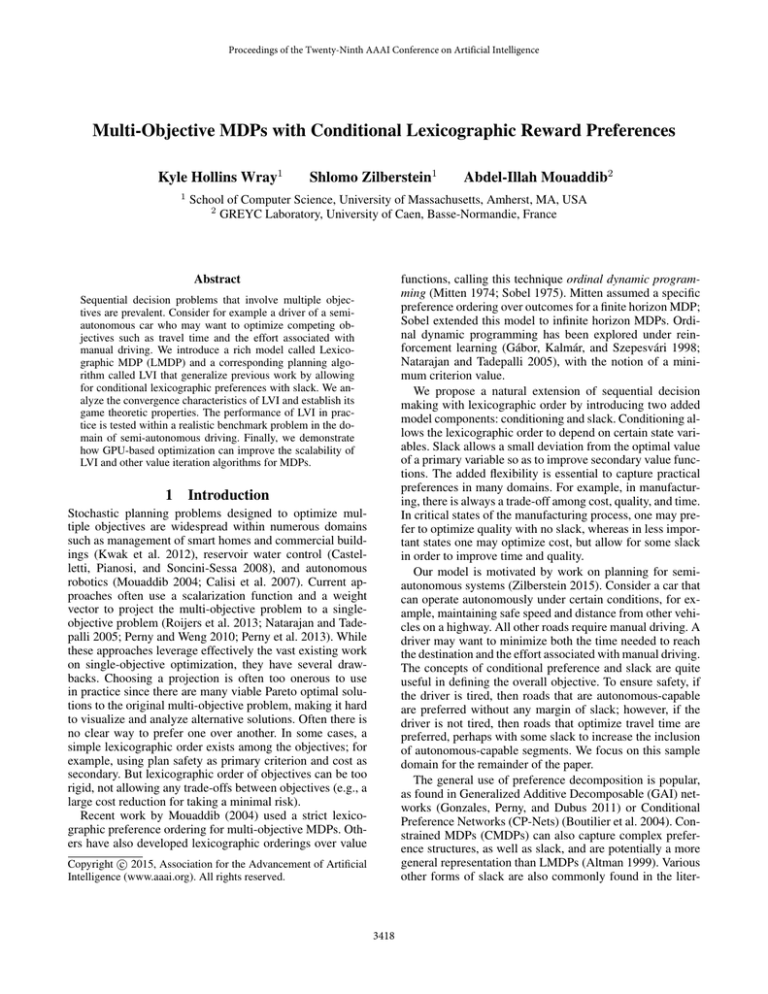
Proceedings of the Twenty-Ninth AAAI Conference on Artificial Intelligence
Multi-Objective MDPs with Conditional Lexicographic Reward Preferences
Kyle Hollins Wray1
1
Shlomo Zilberstein1
School of Computer Science, University of Massachusetts, Amherst, MA, USA
2
GREYC Laboratory, University of Caen, Basse-Normandie, France
Abstract
functions, calling this technique ordinal dynamic programming (Mitten 1974; Sobel 1975). Mitten assumed a specific
preference ordering over outcomes for a finite horizon MDP;
Sobel extended this model to infinite horizon MDPs. Ordinal dynamic programming has been explored under reinforcement learning (Gábor, Kalmár, and Szepesvári 1998;
Natarajan and Tadepalli 2005), with the notion of a minimum criterion value.
We propose a natural extension of sequential decision
making with lexicographic order by introducing two added
model components: conditioning and slack. Conditioning allows the lexicographic order to depend on certain state variables. Slack allows a small deviation from the optimal value
of a primary variable so as to improve secondary value functions. The added flexibility is essential to capture practical
preferences in many domains. For example, in manufacturing, there is always a trade-off among cost, quality, and time.
In critical states of the manufacturing process, one may prefer to optimize quality with no slack, whereas in less important states one may optimize cost, but allow for some slack
in order to improve time and quality.
Our model is motivated by work on planning for semiautonomous systems (Zilberstein 2015). Consider a car that
can operate autonomously under certain conditions, for example, maintaining safe speed and distance from other vehicles on a highway. All other roads require manual driving. A
driver may want to minimize both the time needed to reach
the destination and the effort associated with manual driving.
The concepts of conditional preference and slack are quite
useful in defining the overall objective. To ensure safety, if
the driver is tired, then roads that are autonomous-capable
are preferred without any margin of slack; however, if the
driver is not tired, then roads that optimize travel time are
preferred, perhaps with some slack to increase the inclusion
of autonomous-capable segments. We focus on this sample
domain for the remainder of the paper.
The general use of preference decomposition is popular,
as found in Generalized Additive Decomposable (GAI) networks (Gonzales, Perny, and Dubus 2011) or Conditional
Preference Networks (CP-Nets) (Boutilier et al. 2004). Constrained MDPs (CMDPs) can also capture complex preference structures, as well as slack, and are potentially a more
general representation than LMDPs (Altman 1999). Various
other forms of slack are also commonly found in the liter-
Sequential decision problems that involve multiple objectives are prevalent. Consider for example a driver of a semiautonomous car who may want to optimize competing objectives such as travel time and the effort associated with
manual driving. We introduce a rich model called Lexicographic MDP (LMDP) and a corresponding planning algorithm called LVI that generalize previous work by allowing
for conditional lexicographic preferences with slack. We analyze the convergence characteristics of LVI and establish its
game theoretic properties. The performance of LVI in practice is tested within a realistic benchmark problem in the domain of semi-autonomous driving. Finally, we demonstrate
how GPU-based optimization can improve the scalability of
LVI and other value iteration algorithms for MDPs.
1
Abdel-Illah Mouaddib2
Introduction
Stochastic planning problems designed to optimize multiple objectives are widespread within numerous domains
such as management of smart homes and commercial buildings (Kwak et al. 2012), reservoir water control (Castelletti, Pianosi, and Soncini-Sessa 2008), and autonomous
robotics (Mouaddib 2004; Calisi et al. 2007). Current approaches often use a scalarization function and a weight
vector to project the multi-objective problem to a singleobjective problem (Roijers et al. 2013; Natarajan and Tadepalli 2005; Perny and Weng 2010; Perny et al. 2013). While
these approaches leverage effectively the vast existing work
on single-objective optimization, they have several drawbacks. Choosing a projection is often too onerous to use
in practice since there are many viable Pareto optimal solutions to the original multi-objective problem, making it hard
to visualize and analyze alternative solutions. Often there is
no clear way to prefer one over another. In some cases, a
simple lexicographic order exists among the objectives; for
example, using plan safety as primary criterion and cost as
secondary. But lexicographic order of objectives can be too
rigid, not allowing any trade-offs between objectives (e.g., a
large cost reduction for taking a minimal risk).
Recent work by Mouaddib (2004) used a strict lexicographic preference ordering for multi-objective MDPs. Others have also developed lexicographic orderings over value
c 2015, Association for the Advancement of Artificial
Copyright Intelligence (www.aaai.org). All rights reserved.
3418
ature (Gábor, Kalmár, and Szepesvári 1998). However, as
we show, LMDPs offer a good trade-off between expressive
power and computational complexity, allowing a new range
of objectives to be expressed without requiring substantially
more complex solution methods.
Our primary contributions include formulating the Lexicographic MDP (LMDP) model and the corresponding Lexicographic Value Iteration (LVI) algorithm. They generalize
the previous methods mentioned above with our formulation
of slack variables and conditional state-based preferences.
Additionally, we show that LMDPs offer a distinct optimization framework from what can be achieved using a linearly
weighted scalarization function. Furthermore, we introduce
a new benchmark problem involving semi-autonomous driving together with general tools to experiment in this domain.
Finally, we develop a Graphic Processing Unit (GPU) implementation of our algorithm and show that GPU-based optimization can greatly improve the scalability of Value Iteration (VI) in MDPs.
Section 2 states the LMDP problem definition. Section 3
presents our main convergence results, bound on slack, and
an interesting relation to game theory. Section 4 presents our
experimental results. Finally, Section 5 concludes with a discussion of LMDPs and LVI.
2
Algorithm 1 Lexicographic Value Iteration (LVI)
1:
2:
3:
4:
5:
6:
7:
8:
9:
10:
11:
12:
13:
14:
15:
V Ð0
V1 Ð0
1´γ
while }V ´ V 1 }S
8 ą γ do
1
V ÐV
V f ixed Ð V
for j “ 1, . . . , ` do
for i “ oj p1q, . . . , oj pkq do
S
while }Vi1 ´ Vi }8j ą 1´γ
do
γ
1
Vi psq Ð Vi psq, @s P Sj
Vi psq Ð Bi Vi1 psq, @s P Sj
end while
end for
end for
end while
return V 1
• S “ tS1 , . . . , S` u is a set which forms an `-partition over
the state space S
• o “ xo1 , . . . , o` y is a tuple of strict preference orderings
such that L “ t1, . . . , `u, @j P L, oj is a k-tuple ordering
elements of K
In the interest of clarity, we limit this paper to infinite
horizon LMDPs (i.e., h “ 8), with a discount factor γ P
r0, 1q. The finite horizon case follows in the natural way. A
policy π : S Ñ A maps each state s P S to an action a P A.
Let V “ rV1 , . . . , Vk sT be a set of value functions. Let
each function Viπ : S Ñ R, @i P K, represent the value of
states S following policy π. The stochastic process of MDPs
enable us to represent this using the expected value over the
reward for following the policy at each stage.
8
ˇ
ı
”ÿ
ˇ
γ t Rpst , πpst q, st`1 qˇs0 “ s, π
Vπ psq “ E
Problem Definition
A Multi-Objective Markov Decision Process (MOMDP) is
a sequential decision process in which an agent controls a
domain with a finite set of states. The actions the agent can
perform in each state cause a stochastic transition to a successor state. This transition results in a reward, which consists of a vector of values, each of which depends on the
state transition and action. The process unfolds over a finite
or infinite number of discrete time steps. In a standard MDP,
there is a single reward function and the goal is to maximize the expected cumulative discounted reward over the
sequence of stages. MOMDPs present a more general model
with multiple reward functions. We define below a variant of
MOMDPs that we call Lexicographic MDP (LMDP), which
extends MOMDPs with lexicographic preferences to also
include conditional preferences and slack. We then introduce a Lexicographic Value Iteration (LVI) algorithm (Algorithm 1) which solves LMDPs.
Definition 1. A Lexicographic Markov Decision Process
(LMDP) is a represented by a 7-tuple xS, A, T, R, δ, S, oy:
• S is a finite set of n states, with initial state s0 P S
• A is a finite set of m actions
• T : S ˆAˆS Ñ r0, 1s is a state transition function which
specifies the probability of transitioning from a state s P
S to state s1 P S, given action a P A was performed;
equivalently, T ps, a, s1 q “ P rps1 |s, aq
• R “ rR1 , . . . , Rk sT is a vector of reward functions such
that @i P K “ t1, . . . , ku, Ri : S ˆ A ˆ S Ñ R; each
specifies the reward for being in a state s P S, performing
action a P A, and transitioning to a state s1 P S, often
written as Rps, a, s1 q “ rR1 ps, a, s1 q, . . . , Rk ps, a, s1 qs
• δ “ xδ1 , . . . , δk y is a tuple of slack variables such that
@i P K, δi ě 0
t“0
This allows us to recursively write the value of the state
s P S, given a particular policy π, in the following manner.
ÿ
Vπ psq “
T ps, πpsq, s1 qpRps, πpsq, s1 q ` γVπ ps1 qq
s1 PS
Lexicographic Value Iteration
LMDPs lexicographically maximize Voj piq psq over
Voj pi`1q psq, for all i P t1, . . . , k ´ 1u, j P L, and s P S,
using Vojpi`1q to break ties. The model allows for slack
δoj piq ě 0 (deviation from the overall optimal value). We
will also refer to ηoj piq ě 0 as the deviation from optimal
for a single action change. We show that the classical value
iteration algorithm (Bellman 1957) can be easily modified
to solve MOMDPs with this preference characterization.
For the sake of readability, we use the following convention: Always assume that the ordering is applied, e.g.,
Vi`1 ” Voj pi`1q and t1, . . . , i´1u ” toj p1q, . . . , oj pi´1qu.
This allows us to omit the explicit ordering oj p¨q for subscripts, sets, etc.
First, Equation 1 defines Qi ps, aq, the value of taking an
action a P A in a state s P S according to objective i P K.
ÿ
Qi ps, aq “
T ps, a, s1 qpRi ps, a, s1 q ` γVi ps1 qq (1)
s1 PS
3419
Since value iteration admits exactly one unique fixed
point, any initial value of Vi0 is allowed; we let Vi0 “ Viη .
From this, Qηi ps, πpsqq (Equation 1) exists within the above
equation for Viπ psq. By Equation 2, Viη psq ´ Qηi ps, πpsqq ď
ηi since πpsq P Ak psq Ď ¨ ¨ ¨ Ď Ai`1 psq. Equivalently,
Qηi ps, πpsqq ě Viη psq ´ ηi . Combine all of these facts and
bound it from below.
ř The ηi falls out of the inner equation.
Also, recall that s2 PS T ps3 , πps3 q, s2 q “ 1 and γηi is a
constant. This produces:
´
´
ÿ
ě
T ps, πpsq, st q Ri ps, πpsq, st q ` γ ¨ ¨ ¨
With this definition in place, we may define a restricted
set of actions for each state s P S. For i “ 1, let A1 psq “ A
and for all i P t1, . . . , k ´ 1u let Ai`1 psq be defined as:
Ai`1 psq “ ta P Ai psq| 1max Qi ps, a1 q ´ Qi ps, aq ď ηi u
a PAi psq
(2)
For reasons explained in Section 3, we let ηi “ p1 ´ γqδi .
Finally, let Equation 3 below be the Bellman update equation for MOMDPs with lexicographic reward preferences
for i P K, using slack δi ě 0, for all states s P S. If i ą 1,
then we require Vi´1 to have converged.
Vi psq “ max Qi ps, aq
st PS
(3)
aPAi psq
`γ
´
` γ Viη ps2 q
s1 PS
V̄i ps q “
Vi1 ps1 qrs
3
P Sj s `
Vif ixed ps1 qrs
R Sj s
(5)
Theoretical Analysis
8
ÿ
γ t ηi ě Viη psq ´
t“0
ηi
1´γ
ηi
1´γ
Therefore, let ηi “ p1 ´ γqδi . This guarantees that error
for all states s P S is bounded by δi .
Viη psq ´ Viπ psq ď
Convergence Properties
Strong Bound on Slack
In order to prove the convergence of Algorithm 1, we first
prove that the value iteration component over a partition
with slack is a contraction map. The proof follows from
value iteration (Bellman 1957) and from the suggested proof
by Russel and Norvig (2010). We include it because of its
required modifications and it explains exactly why Assumption 1 is needed. Finally, we include the domain in max
norms, i.e., } ¨ }Z
8 “ maxzPZ | ¨ |.
First we show in Proposition 1 that ηi from Equation 2 may
be defined as p1 ´ γqδi to bound the final deviation from the
optimal value of a state by δi , for i P K. This is designed to
be a worst-case guarantee that considers each state selects an
action as far from optimal as it can, given the slack allocated
to it. The accumulation of error over all states is bounded by
δ. In practice, this strong bound can be relaxed, if desired.
Proposition 1. For all j P L, for i P K, assume 1, . . . , i ´ 1
has converged. Let V η be the value functions returned following Equation 4; Lines 7-10. Let V π be the value functions returned by value iteration, following the resulting optimal policy π, starting at V η . If ηi “ p1´γqδi then @s P Sj ,
Viη psq ´ Viπ psq ď δi .
Proposition 2. For all j P L, for i P K, assume 1, . . . , i ´ 1
has converged, with discount factor γ P r0, 1q. Bi (Equation 4) is a contraction map in the space of value functions
S
S
over s P Sj , i.e., }Bi V1 ´ Bi V2 }8j ď γ}V1 ´ V2 }8j .
Proof. Let the space Yi “ Rz be the space of value
functions for i for z “ |Sj |, i.e., we have Vi “
rVi psj1 q, . . . , Vi psjz qsT P Yi . Let the distance metric di
be the max norm, i.e., }Vi }8 “ maxsPSj |Vi psq|. Since
γ P r0, 1q, the metric space Mi “ xYi , di y is a complete
normed metric space (i.e., Banach space).
Let the lexicographic Bellman optimality equation for i
(Equation 4) be defined as an operator Bi . We must show
that the operator Bi is a contraction map in Mi for all i P
K, given either that i “ 1 or that the previous i ´ 1 has
converged to within of its fixed point.
Proof. For any i P K, the full (infinite) expansion of value
iteration for Viη is as follows (t Ñ 8).
´
´
ÿ
Viπ psq “
T ps, πpsq, st q Ri ps, πpsq, st q ` γ ¨ ¨ ¨
st PS
´ ÿ
¯ ¯¯
´ γηi ¨ ¨ ¨
Viπ psq ě Viη psq ´
This section provides a theoretical analysis of LVI in three
parts. First, we provide a strong lower bound on slack to
complete the definition of LVI. Second, we prove convergence given an important assumption, and explain why the
assumption is needed. Third, we show two properties of
LMDPs: a game theory connection and a key limitation of
scalarization methods in comparison to LMDPs.
`γ
¯¯
We again recognize Qηi ps3 , πps3 qq and place a lower
bound on the next one with Viη ps3 q ´ ηi . This process repeats, each time introducing a new ηi , with one less γ multiplied in front of it, until we reach the final equation. We
obtain the following inequality, and note that if ηi ě 0, then
we may subtract another ηi in order to obtain a geometric
series (i.e., the sum may begin at t “ 0).
(4)
1
´
T ps3 , πps3 q, s2 q Ri ps3 , πps3 q, s2 q
s2 PS
Within the algorithm, we leverage a modified value iteration with slack Bellman update equation (from Equation 3)
denoted as Bi . We either use Vi for s P Sj Ď S or Vif ixed psq
for s P SzSj , as shown in Equation 4 below, with r¨s denoting Iverson brackets.
ÿ
Bi Vi1 psq “ max
T ps, a, s1 qpRi ps, a, s1 q ` γ V̄i ps1 qq
aPAi psq
´ ÿ
´
T ps2 , πps2 q, s1 q Ri ps2 , πps2 q, s1 q
s1 PS
´
¯¯¯ ¯¯
` γ Vi0 ps1 q
¨¨¨
3420
Let V1 , V2 P Yi be any two value function vectors. Apply
Equation 4. For s P Sj , if i “ 1 then Ai psq “ A; otherwise, Ai psq is defined using Ai´1 psq (Equation 2) which by
construction has converged.
Proposition 4. LVI (Algorithm 1) converges to a unique
fixed point V ˚ under Assumption 1 with γ P r0, 1q.
Proof. We must show that for each partition, all value functions converge following the respective orderings, in sequence, to a unique fixed point. We do this by constructing a
metric space of the currently converged values, and the ones
that are “converging” (i.e., satisfying Assumption 1). Then,
we apply Proposition 2 which proves that G is a contraction
map on this space. Finally, since this is true for all partitions
and their value functions, and Assumption 1 guarantees converged values remain stable, it converges to the entire metric
space over the entire partitions and their values.
Let Y be the space of all value functions over partitions
@j P L1 Ď L, value functions Kj1 Ď K, and their states
S which have converged or satisfy Assumption 1. Note that
the base case includes only the first oj p1q P Kj1 from each
j P L1 . Let distance metric d be the max norm, i.e., }V }8 “
maxjPL1 maxiPKj1 maxsPSj |Vi psq|. Thus, the metric space
M “ xY, dy is a Banach space.
Let G be an operator in M following Lines 4-13 in Algorithm 1, i.e., V 1 “ GV using the algorithm’s variables:
V and V 1 . We must show that G is a contraction map. Let
V1 , V2 P Y be any two value function vectors. Rewrite in
terms of Bi and then apply Proposition 2.
S
}Bi V1 ´ Bi V2 }8j “ max | max Q1 ps, aq ´ max Q2 ps, aq|
sPSj
aPAi psq
aPAi psq
As part of the Qp¨q values, we distribute T p¨q to each
Rp¨q and V p¨q in the summations, then apply the property:
maxx f pxq ` gpxq ď maxx f pxq ` maxx gpxq, twice. We
may then pull out γ and recall that for any two functions f
and g, | maxx f pxq ´ maxx gpxq| ď maxx |f pxq ´ gpxq|.
ď γ max max
ÿ
sPSj aPAi psq
s1 PS
ˇ
ˇ
ˇ
ˇ
T ps, a, s1 qˇV̄1 ps1 q ´ V̄2 ps1 qˇ
Now, we can apply Equation 5. Note the requirement that
SzS
S
}V1f ixed ´ V2f ixed }8 j ď }V1 ´ V2 }8j . Informally, this
means that the largest error in the fixed values is bounded by
the current iteration’s largest source of error from partition
j. This is trivially true when performing VI in Algorithm 1
on Lines 6-13 because V f ixed is the same for V1 and V2 ,
S
implying that 0 ď }V1 ´ V2 }8j . Therefore, we are left with
the difference of V1 and V2 over Sj .
ď γ max max
ÿ
sPSj aPAi psq
s1 PSj
ˇ
ˇ
ˇ
ˇ
T ps, a, s1 qˇV1 ps1 q ´ V2 ps1 qˇ
}GV1 ´ GV2 }8 “ max1 max1 max |pGV1 qi psq ´ pGV2 qi psq|
ˇ
ˇ
S
ˇ
ˇ
ď γ max ˇV1 psq ´ V2 psqˇ ď γ}V1 ´ V2 }8j
jPL iPKj sPSj
sPSj
“ max1 max1 max |Bi V1i psq ´ Bi V2i psq|
This proves that the operator Bi is a contraction map on
metric space Mi , for all i P K.
jPL iPKj sPSj
ď γ max1 max1 max |V1i psq ´ V2i psq|
jPL iPKj sPSj
We may now guarantee convergence to within ą 0 of
the fixed point for a specific partition’s value function. We
omit this proof because it is the same as previous proofs and
does not produce more assumptions (unlike Proposition 2).
Proposition 3. For all j P L, for i P K, assume 1, . . . , i ´ 1
has converged. Following Equation 4; Lines 7-10, for any
i P K, Bi converges to within ą 0 of a unique fixed point
S
once }Vit`1 ´ Vit }8j ă 1´γ
γ for iteration t ą 0.
ď γ}V1 ´ V2 }8
Therefore, G is a contraction map. By Banach’s fixed
point theorem, since M is a complete metric space and G
is a contraction map on Y , G admits a unique fixed point
V ˚ P Y . The convergence of G in M produces a new expanded metric space, which converges to a new unique fixed
point in the larger space. This process repeats to completion
until we reach the entire space over Rkˆn , yielding a final
unique fixed point V ˚ .
As part of Proposition 2’s proof, there is an implicit constraint underlying its application; essentially, for a partition
to properly converge, there must be a bound on the fixed
values of other partitions. This is trivially true for the inner
while loop on Lines 8-11, but not necessarily true for the
outer while loop. We formally state the assumption below.
Assumption 1 (Proper Partitions). Let j P L be the partiSzS
S
tion which satisfies }V1f ixed ´ V2f ixed }8 j ď }V1 ´ V2 }8j
from Proposition 2. Also, let i P K such that 1, . . . , i ´ 1
has converged. Assume that this inequality holds until j has
converged to within and then remains fixed.
Intuitively, with respect to LVI, the assumption takes the
partition which is the source of the largest error, and assumes
that it converges first and then remains fixed thereafter. For
example, this can arise in scenarios with goal states, since
the partition without the goal state implicitly depends on the
value functions of the partition with the goal state. We prove
that LVI converges under this assumption.
Relation to Other Models
Interestingly, there is a connection between LMDPs and
game theory. This link bridges the two often distinct fields
of decision theory and game theory, while simultaneously
providing another description of the optimality of an LMDP
policy. Furthermore, it opens the possibility for future work
on game theoretic solvers which produce solutions that map
back from the normal form game to an LMDP policy.
Definition 2 describes this mapping from an LMDP to a
normal form game. Intuitively, each partition can be thought
of as a player in a game. The action a partition can take are
any sub-policy for the states in the partition. We select any
` value functions, one from each partition, and use those as
the payoffs for a normal form game. We show in Proposition 5 that the resulting LMDP’s optimal policy computed
from LVI is, in fact, a Nash equilibrium.
3421
Definition 2. Let LMDP xS, A, T, R, δ, S, oy have value
functions V π for corresponding optimal policy π, the optimal value functions V η , computed via LVI (Algorithm 1).
Let s̄ “ xs1 , . . . , s` y be a state tuple such that @z P L,
sz P Sz . Let ī “ xi1 , . . . , i` y be any tuple of indices iz P K.
The LMDP’s Normal Form Game xL, A, U y is:
• L “ t1, . . . , `u is a set of agents (partitions)
• A “ A1 ˆ¨ ¨ ¨ˆA` is a finite set of joint actions, such that
@z P L, x “ |Sz |, Sz “ tsz1 , . . . , szx u, Az “ Aiz psz1 qˆ
¨ ¨ ¨ ˆ Aiz pszx q
• U “ xu1 , . . . , u` y is a set of utility functions, such
that @z P L, @a P A, sz P s̄, uz paz , a´z q “
z
psz q, Viηz psz q ´ δiz u.
mintViπ,a
z
Figure 1: The example MOMDP for Proposition 6.
if s “ s1 , T ps, leave, s1 q “ 1 if s ‰ s1 , T ps, a, s1 q “ 0
otherwise, and rewards R “ rR1 , R2 sT as shown.
For states s1 and s2 , w1 ă 1{3 and w2 ą 2{3 produce
the policy πw ps1 q “ leave and πw ps2 q “ stay. Similarly, weights w1 ą 1{3 and w2 ă 2{3 produce the policy πw ps1 q “ stay and πw ps2 q “ leave. Only weights
set to w1 “ 1{3 and w2 “ 2{3 allows for ambiguity;
a carefully selected tie-breaking rule alows for the policy
πw ps1 q “ πw ps2 q “ stay.
The exact same logic holds for states s3 and s4 with the
weights reversed at w1 “ 2{3 and w2 “ 1{3 to allow a
tie-breaking rule to produce πw ps3 q “ πw ps4 q “ stay.
Construct the corresponding LMDP with S “ tS1 , S2 u,
S1 “ ts1 , s3 u, S2 “ ts2 , s4 u, o “ xo1 , o2 y, o1 “ x1, 2y,
o2 “ x2, 1y, and δ “ x0, 0y. The policy returned by LVI is
πpsq “ stay for all s P S. This policy is unique since it
cannot be produced by any selection of weights.
Note that we only consider pure strategy profiles. Thus, a
player’s strategy set will be used synonymously with its action set. Similarly, since we consider one stage games, strategy profile will be synonymous with action profile.
Proposition 5. For an LMDP, the optimal policy π is a weak
pure strategy Nash equilibrium of the LMDP’s equivalent
normal form.
Proof. Let LMDP xS, A, T, R, δ, S, oy have optimal policy
π. Let f pπq “ xω1 , . . . , ω` y so that @z P L, x “ |Sz |, Sz “
tsz1 , . . . , szx u, ωz “ xπpsz1 q, . . . , πpszx qy. After applying
the transformation in Definition 2, we must show that the
strategy (action) profile f pπq “ a “ paz , a´z q P A is a
weak pure strategy Nash equilibrium.
By the definition of a (weak) Nash equilibrium, we
must show that @z P L, @a1 P Az , uz paz , a´z q ě
uz pa1 , a´z q. Let π 1 be the corresponding policy for f pπ 1 q “
1
xa1 , . . . , az´1 , a1 , az`1 , . . . , a` y P A. Let V π be the value
functions after value iteration has converged for each value
1
function in K following policy π 1 . Note that Vxπ “ Vxπ ,
π
@x P t1, . . . , iz ´ 1u, and therefore by Equation 2, Aiz “
1
Aπiz . This ensures we may use Proposition 1, by considering
a MOMDP with a reduced number of rewards up to iz .
By Proposition 1, Viπz psz q ě Viηz psz q ´ δi . Apply the fact that π is defined following action az , so
z
psz q “ Viπz psz q. Thus, by Definition 2: uz paz , a´z q “
Viπ,a
z
mintViπz psz q, Viηz psz q ´ δi u “ Viηz psz q ´ δi . There are two
1
cases for Viπz psz q; regardless, the inequality uz paz , a´z q ě
uz pa1 , a´z q is true. Therefore, the strategy (action) profile π
is a Nash equilibrium.
4
Experimentation
Semi-autonomous systems require efficient policy execution involving the transfer of control between human and
agent (Cohn, Durfee, and Singh 2011). Our experiments focus on a semi-autonomous driving scenario in which transfer
of control decisions depend on the driver’s level of fatigue.
The multi-objective model we use is motivated by an extensive body of engineering and psychological research on
monitoring driver fatigue and risk perception (Ji, Zhu, and
Lan 2004; Pradhan et al. 2005). We use real-world road data
from OpenStreetMap1 for sections of the 10 cities in Table 1.
The Semi-Autonomous Driving Domain
LMDP states are formed by a pair of intersections (previous
and current), driver tiredness (true/false), and autonomy (enabled/disabled). The intersection pair captures the direction
of travel. Actions are taken at intersections, as found in path
planning in graphs (e.g., GPS). Due to real world limitations,
autonomy can only be enabled on main roads and highways;
in our case, this means a speed limit greater than or equal to
30 miles per hour. Actions are simply which road to take at
each intersection and, if the road allows, whether or not to
enable autonomy. The stochasticity within state transitions
model the likelihood that the driver will drift from attentive
to tired, following probability of 0.1.
We now show that optimal solutions for LMDPs may not
exist in the space of solutions captured by MOMDPs with
linearly weighted scalarization functions. Hence, LMDPs
are a new distinct multi-objective optimization problem,
while still being related to MOMDPs. Figure 1 demonstrates
the proof’s main idea: Construct a MOMDP with conflicting
weight requirements to produce the LMDP’s optimal policy.
Proposition 6. The optimal policy of an LMDP π may not
exist in the space of solutions captured by its corresponding
scalarized MOMDP’s policy πw .
Proof. Consider the MOMDP depicted in Figure 1, with
S “ ts1 , s2 , s3 , s4 u, A “ tstay, leaveu, T ps, stay, s1 q “ 1
1
3422
http://wiki.openstreetmap.org
City
Chicago
Denver
Baltimore
Pittsburgh
Seattle
Austin
San Franc.
L.A.
Boston
N.Y.C.
|S|
400
616
676
864
1168
1880
2016
2188
2764
3608
|A|
10
10
8
8
10
10
10
10
14
10
w
1.5
6.2
5.6
7.3
29.2
99.4
4235.8
118.7
10595.5
14521.8
CPU
3.3
12.9
14.1
15.4
63.5
433.3
4685.7
273.5
11480.9
16218.5
GPU
3.9
6.4
5.7
7.9
14.2
29.8
159.4
37.8
393.2
525.7
Table 1: Computation time in seconds for weighted scalarized VI (w), and LVI on both the CPU and GPU.
Figure 2: The policy for attentive (above) and tired (below).
Our implementation first transfers the entire LMDP model
from the host (CPU) to the device (GPU). Each partition is
executed separately, with multiple Bellman updates running
in parallel. After convergence, the final policy and values
are transferred back from the device to the host. One of the
largest performance costs comes from transferring data between host and device. LVI avoids this issue since transfers
occur outside each iteration. Our experiments shown in Table 1 were executed with an Intel(R) Core(TM) i7-4702HQ
CPU at 2.20GHz, 8GB of RAM, and an Nvidia(R) GeForce
GTX 870M graphics card using C++ and CUDA(C) 6.5.
Proposition 6 clearly shows that optimal polices for an
LDMP may differ from those of a scalarized MOMDP. One
valid concern, however, is that scalarization methods may
still return a reasonable policy much faster than LVI. For
this reason, we evaluated the computation times of both
weighted VI, as well as LVI run on both a CPU and GPU.
As shown in the table, the runtimes of LVI and scalarized
VI differ by a small constant factor. The GPU version of
LVI vastly improves the potential scales of LMDPs, reaching speeds roughly 30 times that of the CPU.
Rewards are the negation of costs. Thus, there are two cost
functions: time and fatigue. The time cost is proportional to
the time spent on the road (in seconds), plus a small constant
value of 5 (seconds) which models time spent at a traffic
light, turning, or slowed by traffic. The fatigue cost is proportional to the time spent on the road, but is only applied if
the driver is tired and autonomy is disabled; otherwise, there
is an -cost. The absorbing goal state awards zero for both.
It is natural to minimize the time cost when the driver is
attentive and the fatigue cost when the driver is tired. We
allow for a 10 second slack in the expected time to reach the
goal, in order to favor selecting autonomy-capable roads.
Figure 2 shows an example optimal policy returned by
LVI for roads north of Boston Commons. Each road at an
intersection has an action, denoted by arrows. Green arrows
denote that autonomy was disabled; purple arrows denote
that autonomy was enabled. The blue roads show autonomycapability. We see that the policy (green) correctly favors a
more direct route when the driver is attentive, and favors the
longer but safer autonomous path when the driver is tired.
This is exactly the desired behavior: Autonomy is favored
for a fatigued driver to improve vehicle safety.
We created simple-to-use tools to generate a variety of
scenarios from the semi-autonomous driving domain. This
domain addresses many of the existing concerns regarding
current MOMDP evaluation domains (Vamplew et al. 2011).
In particular, our domain consists of real-world road data,
streamlined stochastic state transitions, both small and large
state and action spaces, policies which are natural to understand, and the ability for both qualitative and quantitative
comparisons among potential algorithms.
5
Our work focuses on a novel model for state-dependent
lexicographic MOMDPs entitled LMDPs. This model naturally captures common multi-objective stochastic control
problems such as planning for semi-autonomous driving.
Competing approaches such as linearly weighted scalarization involve non-trivial tuning of weights and—as we
show—may not be able to produce the optimal LMDP policy for an LMDP. Our proposed solution, LVI, converges
under a partition-dependent assumption and is amenable to
GPU-based optimization, offering vast performance gains.
Within the domain of semi-autonomous driving, policies
returned by LVI successfully optimize the multiple statedependent objectives, favoring autonomy-capable roads
when the driver is fatigued, thus maximizing driver safety.
In future work, we plan to enrich the semi-autonomous
driving domain and make the scenario creation tools public
to facilitate further research and comparison of algorithms
for multi-objective optimization. We also plan to further investigate the analytical properties and practical applicability
of LVI and its GPU-based implementation.
GPU-Optimized LVI
We explore the scalability of LVI in a GPU-optimized implementation using CUDA2 . VI on GPUs has been shown to improve performance and enable scalability (Jóhannsson 2009;
Boussard and Miura 2010). Our approach for LVI exploits
this structure of Bellman’s optimality equation: independent
updates of the values of states. LVI also allows us to run each
partition separately, further improving its scalability.
2
Conclusion
https://developer.nvidia.com/about-cuda
3423
6
Acknowledgements
Natarajan, S., and Tadepalli, P. 2005. Dynamic preferences
in multi-criteria reinforcement learning. In Proceedings of
the 22nd International Conference on Machine learning,
601–608.
Perny, P., and Weng, P. 2010. On finding compromise solutions in multiobjective Markov decision processes. In Proceedings of the European Conference on Artificial Intelligence, 969–970.
Perny, P.; Weng, P.; Goldsmith, J.; and Hanna, J. 2013. Approximation of Lorenz-optimal solutions in multiobjective
Markov decision processes. In Proceedings of the 27th AAAI
Conference on Artificial Intelligence, 92–94.
Pradhan, A. K.; Hammel, K. R.; DeRamus, R.; Pollatsek, A.;
Noyce, D. A.; and Fisher, D. L. 2005. Using eye movements
to evaluate effects of driver age on risk perception in a driving simulator. Human Factors: The Journal of the Human
Factors and Ergonomics Society 47(4):840–852.
Roijers, D. M.; Vamplew, P.; Whiteson, S.; and Dazeley,
R. 2013. A survey of multi-objective sequential decisionmaking. Journal of Artificial Intelligence Research 48:67–
113.
Russell, S., and Norvig, P. 2010. Artificial Intelligence: A
modern approach. Upper Saddle River, New Jersey: Prentice Hall.
Sobel, M. J. 1975. Ordinal dynamic programming. Management Science 21(9):967–975.
Vamplew, P.; Dazeley, R.; Berry, A.; Issabekov, R.; and
Dekker, E. 2011. Empirical evaluation methods for multiobjective reinforcement learning algorithms. Machine Learning 84(1-2):51–80.
Zilberstein, S. 2015. Building strong semi-autonomous systems. In Proceedings of the 29th AAAI Conference on Artificial Intelligence.
We thank Laurent Jeanpierre and Luis Pineda for fruitful discussions of multi-objective MDPs. This work was supported
in part by the National Science Foundation grant number
IIS-1405550.
References
Altman, E. 1999. Constrained Markov Decision Processes,
volume 7. CRC Press.
Bellman, R. E. 1957. Dynamic Programming. Princeton,
NJ: Princeton University Press.
Boussard, M., and Miura, J. 2010. Observation planning
with on-line algorithms and GPU heuristic computation. In
ICAPS Workshop on Planning and Scheduling Under Uncertainty.
Boutilier, C.; Brafman, R. I.; Domshlak, C.; Hoos, H. H.;
and Poole, D. 2004. CP-nets: A tool for representing and
reasoning with conditional ceteris paribus preference statements. Journal of Artificial Intelligence Research 21:135–
191.
Calisi, D.; Farinelli, A.; Iocchi, L.; and Nardi, D. 2007.
Multi-objective exploration and search for autonomous rescue robots. Journal of Field Robotics 24(8-9):763–777.
Castelletti, A.; Pianosi, F.; and Soncini-Sessa, R. 2008. Water reservoir control under economic, social and environmental constraints. Automatica 44(6):1595 – 1607.
Cohn, R.; Durfee, E.; and Singh, S. 2011. Comparing actionquery strategies in semi-autonomous agents. In Proceedings
of the 10th International Conference on Autonomous Agents
and Multiagent Systems, 1287–1288.
Gábor, Z.; Kalmár, Z.; and Szepesvári, C. 1998. Multicriteria reinforcement learning. In Proceedings of the 15th
International Conference on Machine Learning, volume 98,
197–205.
Gonzales, C.; Perny, P.; and Dubus, J. P. 2011. Decision
making with multiple objectives using GAI networks. Artificial Intelligence 175(78):1153 – 1179.
Ji, Q.; Zhu, Z.; and Lan, P. 2004. Real-time nonintrusive
monitoring and prediction of driver fatigue. IEEE Transactions on Vehicular Technology 53(4):1052–1068.
Jóhannsson, Á. P. 2009. GPU-based Markov decision process solver. Master’s thesis, School of Computer Science,
Reykjavı́k University.
Kwak, J.-Y.; Varakantham, P.; Maheswaran, R.; Tambe, M.;
Jazizadeh, F.; Kavulya, G.; Klein, L.; Becerik-Gerber, B.;
Hayes, T.; and Wood, W. 2012. SAVES: A sustainable multiagent application to conserve building energy considering
occupants. In Proceedings of the 11th International Conference on Autonomous Agents and Multiagent Systems, 21–28.
Mitten, L. G. 1974. Preference order dynamic programming.
Management Science 21(1):43–46.
Mouaddib, A.-I. 2004. Multi-objective decision-theoretic
path planning. In Proceedings of the IEEE International
Conference on Robotics and Automation, volume 3, 2814–
2819.
3424

